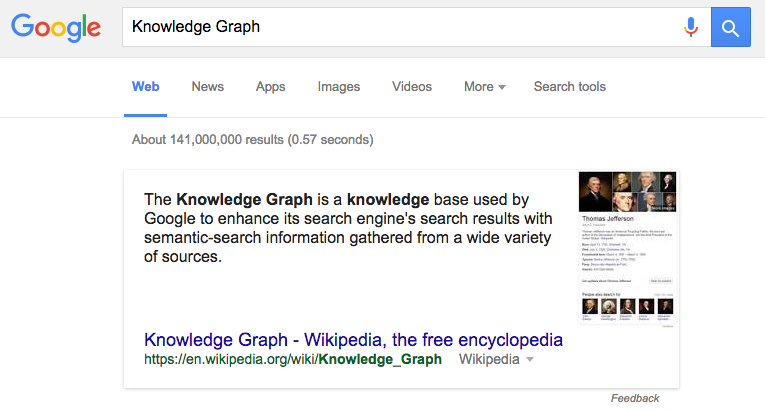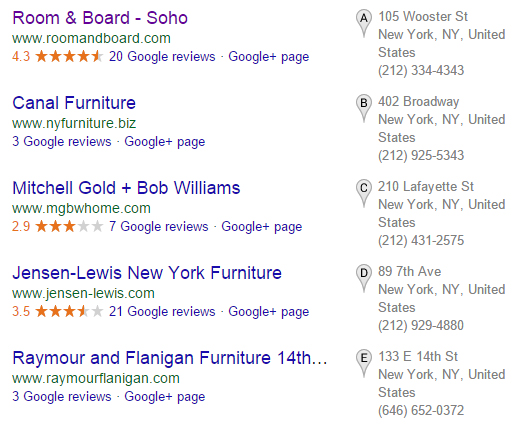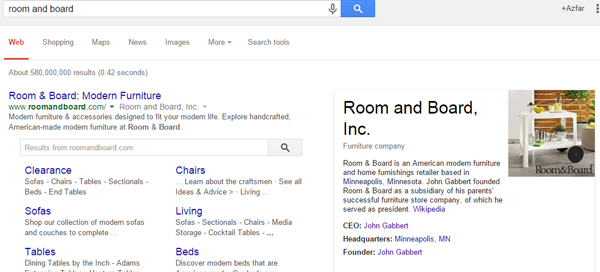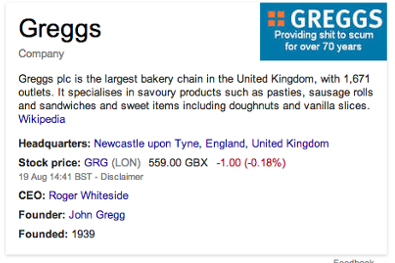Steph W. from SEOPressor


...help you check your website and tell you exactly how to rank higher?


76
score %
SEO Score

Found us from search engine?
We rank high, you can too.
SEOPressor helps you to optimize your on-page SEO for higher & improved search ranking.
By vivian on May 18, 2015

If you’ve done any kind of online marketing over the last few years, then you’re probably familiar with how quickly the landscape can change, sometimes almost instantaneously! New marketing features are popping up all the time, often requiring that you adjust your inbound marketing strategies on the fly.
Take for example the Knowledge Graph. The Knowledge Graph is actually a feature that was launched three years ago, but Google has been slowly introducing it into its search page, and it could end up having a big impact on SEO in the future.
[bof_display_offer id=9250]

Here’s a Knowledge Graph panel explaining itself!
The Knowledge Graph is a system of information that Google provides in order to enhance the queries of users. It is not based on providing users with more quality links. Instead, it’s meant to provide facts and answers to questions that users have searched for. When you do a search, most of the time a list of organic results will show up.
Every once in a while, you’ll see a box of information above the list of results. This is the Google Knowledge Graph. For example, if you type in a search query that asks what the weather will be like tomorrow, odds are a Knowledge Graph will pop up that shows some basic information about the weather over the following week, including highs and lows. Underneath this information is the typical list of links.
This can work wonders for a brand as well. Do a search for something like “coffee shop” and there’s a chance you’ll be provided with a Knowledge Graph that lists several coffee shops within your area as well as customer reviews of those places along with some additional information.
It’s obvious that Google is making a concerted effort to get away from the reliance on keywords and to become much more semantic in its ability to understand user queries and to provide more informed answers and information.
Now, it may seem like Google Knowledge Graphs only displays information about the bigger brands or about the biggest celebrities, which means that small or mid-sized business owners would have no control over the information that the Knowledge Graphs ends up displaying. However, this is actually one of the more common misconceptions born out of the early appearance of Knowledge Graphs.
What many don’t realize is that anyone can have a certain degree of control on what Google chooses to display on their Knowledge Graphs!

The Knowledge Graph is not actually designed with a business purpose in mind. However, it can be very beneficial to companies, even smaller, lesser known brands. The following are a few reasons why you should get started with Google Knowledge Graphs:
Increase your exposure – Say you have a small furniture store in Queens, NY. If someone in Queens does a search for furniture stores nearby their location, and your store happens to be a mile away from them, the Google Knowledge Graph may display your company’s information above its listings. This is amazing exposure – you’re basically getting free ad placement. People looking for certain products or services may never have heard of you before information about your company popped up in the Knowledge Graph. The Knowledge Graph may also provide them with links to reviews of your business, contact information and more.

Ad space for free!
Obtain more local business – Using the previous example of the local furniture store, Google Knowledge Graph is bound to help local businesses obtain more local exposure. Customers looking for products and services don’t always want to order them online – and sometimes there are services and products that can only be obtained in person. For example; restaurants, bars, coffee shops and car repair services, just to name a few.

Sometimes all we need is to grab a cup of coffee somewhere near.
Appear established – When information about your brand pops up, users will assume that you are a well established brand, especially if you have photographs up and positive reviews. Searchers will assume you are more established than other businesses that only features a blank space beside their search results.

Think I’ll pass!
Easier to get results – Unlike in SEO where we are locked in an eternal struggle to compete with others to rank for popular keywords, Knowledge Graph display is comparably easier to obtain. This is because company names in most cases are unique and your website will most definitely ranked first for searches done on your company name. Half of the job is already done so from there onwards it’s just a matter of supplying Google with the right information to get your Knowledge Graph panel displayed!

Much better!
Prevent mistakes – If you ignore Knowledge Graphs, then you could be doing your brand a disservice. A few years ago, Google unintentionally used a photograph for Gregg that was sourced from a satirical website and used it for its Google Knowledge Graph – the photograph showed the Gregg logo but with an offensive slogan that satirized their products and services. Had Gregg not paid attention to its Google Knowledge Graphs, it wouldn’t have caught the mistake, which would have led to more damage to their brand’s reputation and identity. By keeping track of your Knowledge Graphs and help provide the right information, you can reduce the likelihood of Google sourcing them from unsavoury places.

Pardon my French

So now you should have a pretty good idea of what Google Knowledge Graphs are. But how exactly do they work? The Knowledge Graph system is based off of connecting as many entities to as much information on the Internet as possible, thereby being able to provide relevant information to the user.
How exactly do they do this? By outsourcing. Google builds its knowledge base by extracting data from different sources around the web, including the CIA World Factbook and Wikipedia, as well as more subject specific resources, including the World Bank, IMDB and Weather Underground. Not to mention that Google has its own huge source of search data to draw from as well.
This doesn’t mean that the ability to be displayed in a Google Knowledge Graph is solely dependent on whether or not any information about your company already exists within their sources. You can also help supply the information yourself by using means such as:
You can learn more on how you can influence Google Knowledge Graph display in this article:

Google Knowledge Graph has already started to picking up the pace, and is going to end up being even more important in the coming years. However, it’s still not totally perfect, as the Gregg incident showed. These kinds of mistakes can still happen, but through initiatives such as the feedback function and improvement of its sources, Google is working hard at improving it and progress is starting to show.
And although there are still a lot of query types still not covered by the Knowledge Graph, more is added day by day as Google improves its algorithm and functionality. It’s a good idea to begin considering its benefits while a lot of businesses out there are still unaware of its tremendous potential, and get ahead!
I have written the second part of this post on how you can get your business on the Knowledge Graph. Be sure to check it out!
[This blog post was originally written and published by Azfar on May 18, 2015. It is most recently updated by Howard Go on Jun 02, 2020]
Updated: 7 January 2026


Save thousands of dollars (it’s 100x cheaper)

Zero risk of Google penalty (it’s Google-approved)

Boost your rankings (proven by case studies)
Rank High With This Link Strategy
Precise, Simplified, Fast Internal Linking.
